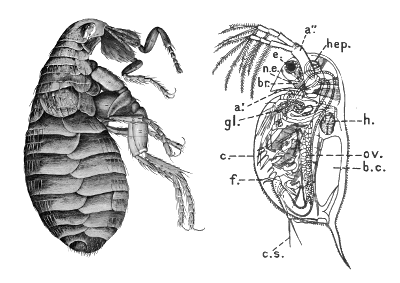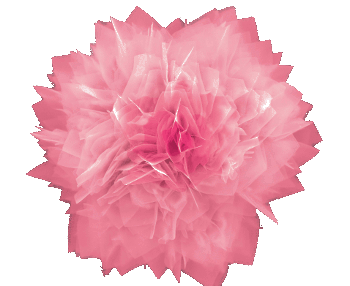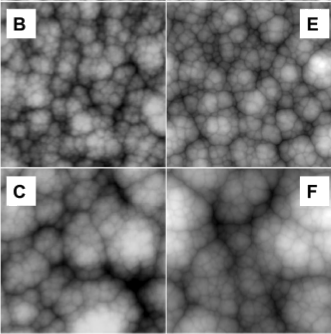Inorganic Flowers
November 21, 2012
One interesting fact of life is that
patterns tend to repeat.
Nature, in her
evolutionary wisdom, will reuse successful
body plans across
species. One interesting example of this is the "water flea" (
Daphnia), a
planktonic crustacean that resembles an
insect flea (see figure). Another crustacean, the
lobster, also has a resemblance to insects.

Flea image from Robert Hooke's Micrographia (1665, left), and an image of a Daphnia from E. Ray Lankester's, A Treatise of Zoology (1909, right).
(Sources: left image and right image)
The
invention of the
microscope showed how far down the length scale such patterns will appear.
Robert Hooke's Micrographia, published in 1665 after nearly a century's perfection of
optics, was the first major
treatise on the microscopic world.[1] In more recent times,
Ernst Haeckel's 1904 book,
Kunstformen der Natur (Art Forms of Nature), examined
symmetry in microscopic life forms. The
Radiolaria reviewed in Haeckel's book are a prime example of symmetrical patterns on a microscopic scale.
In the
inorganic world, there are
physical forces that cause pattern formation as well. Some of these patterns resemble objects in the
biological domain, although I can't see how
flowers of sulfur resemble
flowers. However, there have been two recently published papers about microscopic inorganic structures that do resemble flowers.[2-5]
A team of
materials scientists from
North Carolina State University, with funding from the
U.S. Army Research Office, has been growing
nanoscale flowers of
germanium sulfide (GeS) with
petals just 20-30
nanometers thick (see photograph).[2]

A flower of Germanium-Sulfide.
Germanium sulfide nanoflowers created by materials scientists at NCSU have petals just 20-30 nanometers thick.
(North Carolina State University image))
These flowers are created not just for their
aesthetic value. This type of growth gives a high
surface area, which can be useful for
photovoltaic devices, or as
electrodes in
lithium ion batteries.[2] One material advantage is that GeS is relatively inexpensive and
non-toxic, whereas other photovoltaic materials, such as
cadmium telluride, are toxic.
These nanoflowered films are created by the usual
chemical vapor deposition process in which
vapors of the material are condensed onto a cooler
substrate. Growth rate is important for the creation of this unusual structure, with lower growth rates allowing a
diffusion of
molecules on the surface and formation of the flowers. Too high a growth rate leads to clumps of material forming on the surface, instead, in a mass-transport-limited condition.[2-3]
The growth of clumps in chemical vapor deposition leads us to another paper with a flower motif. This time, it's the
cauliflower, which might be stretching the flower
analogy a bit too far, but it's
science just the same.
A team of
scientists and
mathematicians from the
Universidad Pontificia Comillas (Madrid, Spain), the
Universidad Carlos III de Madrid (Legané, Spain), the
École Polytechnique - CNRS (Palaiseau, France), the
Instituto de Ciencia de Materiales de Madrid (Madrid, Spain), and the
Katholieke Universiteit (Leuven, Belgium) have examined such material growth and developed a model of the cauliflower structure that extends seven orders of magnitude in length from thin films to actual cauliflowers.[4-5]

Nanocauliflower CVD surface growth.
Leftmost images are AFM micrographs, while the rightmost images are the results of a computer model.
(Fig. 1 of ref. 5, via the arXiv Preprint Server).[5)]
In their
experiments, they looked at thin,
amorphous,
hydrogenated,
carbon films grown under mass-transport-limited conditions. In such growth, the film growth is unstable, and the surface resembles a cauliflower plant.[5] They found that non-locality,
non-conservation, and
randomness are the main mechanisms controlling the formation of this shape.[5]
The authors propose a
mathematical model, based on such parameters, for this growth process. It appears that the model applies to most cases in which non-local interface growth occurs.[5] As the authors state in their paper,
"We also show that the surfaces of actual cauliflower plants and combustion fronts obey the same scaling laws... Thus, a theoretical justification is provided, that had remained elusive thus far, for the remarkable similarity between the textures of surfaces found for systems that differ widely in physical nature and typical scales."[5]
References:
- Robert Hooke, "Micrographia - Some Physiological Descriptions of Minute Bodies Made by Magnifying Glasses with Observations and Inquiries Thereupon," Project Gutenberg.
- Matt Shipman, "Researchers Create 'Nanoflowers' for Energy Storage, Solar Cells," North Carolina State University Press Release, October 11, 2012.
- Chun Li, Liang Huang, Gayatri Pongur Snigdha and Linyou Cao, "Role of Boundary Layer Diffusion in Vapor Deposition Growth of Chalcogenide Nanosheets: The Case of GeS," ACS Nano, Article ASAP, DOI: 10.1021/nn303745e, September 25, 2012.
- Mario Castro, Rodolfo Cuerno, Matteo Nicoli, Burgos Luis Vazquez and J G Buijnsters, "Universality of cauliflower-like fronts: from nanoscale thin films to macroscopic plants," New Journal of Physics (Provisionally scheduled for October 2012).
- Mario Castro, Rodolfo Cuerno, Matteo Nicoli, Burgos Luis Vazquez and J G Buijnsters, "Universality of cauliflower-like fronts: from nanoscale thin films to macroscopic plants," arXiv Preprint Server, September 10, 2012.
Permanent Link to this article
Linked Keywords: Pattern; Nature; evolution; body plan; species; Daphnia; plankton; crustacean; insect; flea; lobster; Robert Hooke; Micrographia; invention; microscope; optics; treatise; Ernst Haeckel; Kunstformen der Natur; symmetry; Radiolaria; inorganic; physical force; biological domain; flowers of sulfur; flowers; materials scientist; North Carolina State University; United States Army Research Laboratory; U.S. Army Research Office; nanoscopic scale; nanoscale; germanium sulfide; petal; nanometer; aesthetic; surface-area-to-volume ratio; surface area; photovoltaics; photovoltaic device; electrode; lithium ion battery; non-toxic; cadmium telluride; chemical vapor deposition; vapor; substrate; diffusion; molecule; cauliflower; analogy; science; scientist; mathematician; Universidad Pontificia Comillas (Madrid, Spain); Universidad Carlos III de Madrid (Legané, Spain); École Polytechnique - CNRS (Palaiseau, France); Instituto de Ciencia de Materiales de Madrid (Madrid, Spain); Katholieke Universiteit (Leuven, Belgium); atomic force microscopy; AFM micrograph; computer simulation; computer model; arXiv Preprint Server; experiment; amorphous; hydrogenated; carbon; conservation law; non-conservation; randomness; mathematics; mathematical; Project Gutenberg.